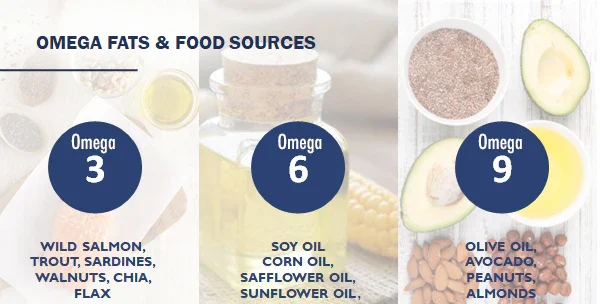Omega-3 fats are essential fats that have important benefits for your heart, brain, and metabolism. While omega-6 fats provide your body with energy, they are abundant in our diet; however, most people don’t consume enough omega-3s. Omega-9 fats are nonessential fats that your body can produce.
Omega-3, omega-6, and omega-9 fatty acids are all important dietary fats.
They all have health benefits, but it’s important to get the right balance between them. An imbalance in your diet may contribute to a number of chronic diseases.
Here’s a guide to omega-3, -6 and -9 fatty acids, including:

Omega-3 fatty acids are polyunsaturated fats, a type of fat your body can’t make.
The term “polyunsaturated” refers to their chemical structure, as “poly” means many and “unsaturated” refers to double bonds. Together they mean that omega-3 fatty acids have many double bonds.
“Omega-3” refers to the position of the final double bond in the chemical structure, which is three carbon atoms from the “omega,” or tail end of the molecular chain.
Since the human body can’t produce omega-3s, these fats are referred to as “essential fats,” meaning that you have to get them from your diet.
The American Heart Association (AHA) recommends eating at least two portions of fish per week, particularly oily fish, which is rich in omega-3 fatty acids.
There are many types of omega-3 fats, which differ based on their chemical shape and size. Here are the three most common:
Omega-3 fats are a crucial part of human cell membranes. They also have other important functions, including:
Like omega-3s, omega-6 fatty acids are polyunsaturated fatty acids. However, the last double bond is six carbons from the omega end of the fatty acid molecule.
Omega-6 fatty acids are also essential, so you need to obtain them from your diet.
They mainly provide energy. The most common omega-6 fat is linoleic acid, which the body can convert to longer omega-6 fats such as arachidonic acid (AA).
Like EPA, AA produces eicosanoids. However, the eicosanoids that AA produces are more pro-inflammatory.
Pro-inflammatory eicosanoids play a key role in the immune system. However, when the body produces too many, they can increase the risk of inflammation and inflammatory disease.
A healthy ratio of omega-6 to omega-3 fatty acids appears to be between 1-to-1 and 4-to-1, but studies suggest that people who follow a typical Western diet may consume a ratio of between 15-to-1 and almost 17-to-1.
Some omega-6 fatty acids have shown benefits in treating symptoms of chronic disease.
Gamma-linolenic acid (GLA) is an omega-6 fatty acid found in certain oils, such as:
When consumed, much of it is converted to another fatty acid called dihomo-gamma-linolenic acid (DGLA).
Research suggests that GLA and DGLA may have some health benefits. For example, GLA may help reduce symptoms of inflammatory conditions. However, more research is needed.
The authors of one study concluded that taking supplements of another form of omega-6 — conjugated linoleic acid (CLA) — may help reduce fat mass in humans.
Omega-9 fatty acids are monounsaturated, meaning they only have one double bond.
It’s located nine carbons from the omega end of the fatty acid molecule.
Oleic acid is the most common omega-9 fatty acid and the most common monounsaturated fatty acid in the diet.
Omega-9 fatty acids aren’t strictly “essential,” as the body can produce them.
However, consuming foods rich in omega-9 fatty acids instead of other types of fat may have health benefits.
A 2015 study found that feeding mice diets high in monounsaturated fat improved insulin sensitivity and decreased inflammation.
The same study found that humans who ate high monounsaturated fat diets had less inflammation and better insulin sensitivity than those who ate diets high in saturated fat.
Combined omega 3-6-9 supplements usually provide each of these fatty acids in suitable proportions, such as 2-to-1-to-1 for omega 3-6-9.
Such oils can help increase your intake of omega 3 fats and enhance your balance of fatty acids so that the ratio of omega 6 to omega 3 is less than 4-to-1.
However, most people already get enough omega 6 from their diet, and the body produces omega9. For this reason, most people do not need to supplement with these fats.
Instead, it’s best to focus on getting a good balance of omega 3, 6, and 9 fatty acids from your diet.
Ways of doing this include eating at least two portions of oily fish per week and using olive oil for cooking and in salad dressings.
In addition, try to limit omega 6 intake by limiting your consumption of other vegetable oils and fried foods that have been cooked in refined vegetable oils.
People who do not get enough omega 3 from their diet may benefit from an omega 3 supplement rather than a combined omega 3-6-9 supplement.
Combined omega 3-6-9 supplements are popular, but they generally provide no additional benefit over taking omega 3 alone.
Omega-6s are essential in certain quantities, but they’re present in many foods. People who follow a Western diet may already consume too many.
Additionally, the body can produce omega 9 fats, and they’re easily obtained in the diet. So you don’t need to take them in supplement form.
Therefore, although combined supplements contain optimal omega 3-6-9 ratios, taking just omega3s will likely provide you with the most health benefits.
We only deal with original products
We safely store the products in 24hours air-conditioning storage
however you are okay, Cash on Delivery or Transfer
You Need Help? Here We Are No Matter Which Time
Receive the latest news, offers and deals going on at AFsupplements
© 2025 AFsupplements.com All Rights Reserved